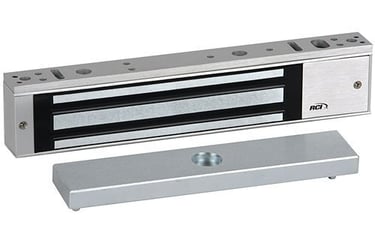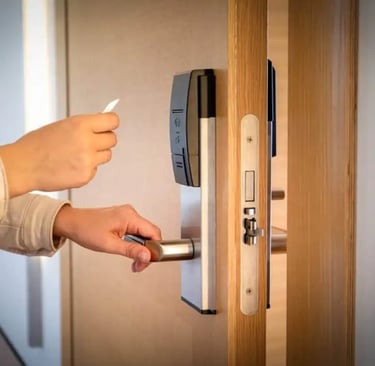Door Control
Understanding the hardware that keeps your doors secure and functional
Electronic Access Control Door Entry Devices
Electronic access control replaces mechanical keys with specialized locks and readers. Common electronic locks include magnetic locks, electric strikes, mortise/cylindrical locks, and electrified panic bars, each with unique installation and safety characteristics. Readers may use 125 kHz prox cards (e.g. HID Prox), 13.56 MHz smartcards (HID iCLASS, MIFARE), or biometrics to grant access. Industry credential standards like FIPS 201 (for U.S. federal PIV/CAC cards) and TWIC (Transportation Worker ID Card) ensure compatibility with government IDs. The sections below describe the hardware components of these systems, including lock types, readers, sensors, and code requirements.
Types of Electronic Locks
Electronic door locks come in several hardware types:
Magnetic Locks (Maglocks): An electromagnet (typically mounted on the door frame) holds a matching armature plate on the door. When powered, the magnet generates very high holding force (often >1000 lbs). Maglocks have no moving parts, making them durable and low-maintenance. They are inherently fail-safe (power-on to lock), so if power fails or an alarm triggers, the door automatically unlocks for emergency egress.
Electric Strikes: These replace the conventional metal strike plate in the door frame with an electromechanical unit. When the strike is activated (by power or lack of power, depending on wiring), it allows the latchbolt from the door to retract without turning the handle. Electric strikes are retrofit-friendly (they use existing locksets) and relatively inexpensive. They come in fail-safe and fail-secure models: a fail-safe strike releases (unlocks) on power loss, while a fail-secure strike locks on power loss.
Electrified Cylindrical and Mortise Locks: These are complete locksets with built-in electronics. An electrified cylindrical lock is surface-mounted on the door (like a typical doorknob or lever set) but contains an electronic actuator. An electrified mortise lock sits in a pocket (mortise) cut into the door’s edge. Both operate like normal locks (deadbolt or latch) but can be retracted remotely. They can be wired fail-safe or fail-secure. In practice they provide high security and a “traditional” look: the lock still has a key or manual override but will also respond to electronic access commands.
Electrified Panic (Crash) Bars: Push-bar devices allow people to exit by pushing on the bar. An electrified crash bar can control entry: it remains locked from the exterior until released electronically. Importantly, crash bars always allow egress. In stairwells and emergency exits, codes require these to be fail-safe (the bar opens under power loss). In other locations a crash bar may be fail-secure (locked on power loss) if a battery backup or alarm integration is in place. Because they meet fire egress codes, electrified panic bars are commonly used on secondary exits and stairwell doors.






All these locks must comply with life-safety requirements. Building codes mandate that exit doors unlock automatically on fire alarm or power loss. For example, maglocks must tie into the fire alarm panel so a trigger immediately drops the lock. In summary, fail-safe locks (unlock on power-off) are used where free egress is critical, while fail-secure locks (stay locked on power-off) are chosen for security, provided an alternate egress method is assured.
Readers and Credentials
Door readers form the bridge between a user’s credential (card, fob, fingerprint, etc.) and the lock. Common reader/credential technologies include:
Proximity (125 kHz) Readers: These read old-style prox cards or keyfobs. Products like HID’s Prox readers operate at low frequency and simply detect a unique ID. They are robust, inexpensive, and considered an industry standard for entry-level control. (Because 125 kHz prox has no strong encryption, higher-security sites have largely migrated to newer formats.)
Smartcard (13.56 MHz) Readers: Modern access systems often use contactless smartcards (ISO 14443) at 13.56 MHz. Examples include HID iCLASS and NXP MIFARE cards. These cards can store encrypted information and multiple applications on-chip. Readers for these cards typically support advanced features like key diversification and can interoperate with multiple card types. For instance, HID iCLASS readers can handle various HID formats and enable pairing with biometrics or PC logon credentials.
Biometric Readers: These use physiological traits. Fingerprint and facial recognition readers have become common. Some systems even combine a smartcard and a fingerprint scan: a reader will read your PIV or TWIC card and verify that your live fingerprint matches the biometric template stored on the card. Biometric readers remove the need for a card in some applications (e.g. a fingerprint alone can unlock a door), offering convenience and strong authentication.
Credential Standards (FIPS, TWIC, etc.): Access readers are often certified to accept standardized credentials. FIPS 201 is the U.S. Federal ID standard specifying the PIV (Personal Identity Verification) card for government use. Readers that are FIPS-201 compliant can read PIV/CAC cards (and similar cards like the TWIC) and enforce the required security (smartcard encryption, fingerprint match, etc.). The TWIC card (for port and transportation workers) is essentially a biometric smartcard based on the same standards. In fact, all U.S. government-issued cards (PIV, CAC, TWIC) derive from FIPS 201 specifications. Thus, a FIPS-201-capable reader can often read multiple card types, enabling multi-factor access at secure facilities.
Door Position Sensors
Most access-controlled doors include a door position switch (magnetic contact) to detect if the door is open or closed. A small magnet is mounted on the door and a matching sensor (reed switch) on the frame. When the door closes, the magnet pulls the switch contacts closed. Opening the door breaks that circuit. This status signal is wired into the access panel or alarm system. For example, Security Door Controls (SDC) MC-series sensors use a recessed magnetic contact to monitor “door position status”. If the door is opened, the change in state alerts the controller. Such sensors ensure the system knows if a door has been propped open or left ajar. They are often used alongside lock status (to detect a forced entry) and contribute to the overall integrity of the access control system.
Request-to-Exit (REX) Devices
Even a locked door must allow people to exit easily. Request-to-exit devices let occupants unlock the door from the inside without a credential. Common REX devices include:
Exit Buttons/Plates: A wall-mounted push-button or push-plate by the door. Pressing it unlocks the door. This is a simple, reliable REX device.
Motion/IR Sensors: A passive infrared (PIR) sensor mounted on the ceiling or wall can detect someone approaching from the inside. Some systems use active IR sensors aimed at the door handle (to avoid false triggers). When these sensors detect a person intent on exiting, they send an unlock signal.
Codes often require two REX methods on a door. For example, some jurisdictions mandate that both a push-button and a motion sensor be provided on the same exit door. This redundancy ensures that if one device fails (or if someone bypasses it), the other still allows egress. (One explanation is that a person bent over, or using a wheelchair, might not trigger an overhead sensor, so a button is also needed, and vice versa.) Manufacturers of REX hardware explicitly note this requirement. For instance, BEA’s access sensor guide says: “Building codes often require two forms of exit devices on a door, such as a motion sensor and a push button”.
High-quality REX systems might use logic modules that coordinate multiple inputs (motion, button, door status) to manage egress smoothly. All REX devices are inherently fail-safe (they do not require power to allow exit); they usually operate with supervised wiring so that the panel can detect a wiring fault.
Fail-Safe vs Fail-Secure (Safety Considerations)
As noted, fail-safe locks unlock on power loss, while fail-secure locks remain locked on power loss. For life safety, exit doors must unlock in an emergency. Thus, by code:
Maglocks are almost always wired fail-safe and tied into the fire alarm. “All businesses are required to have electromagnetic locks…connected to the fire alarm system. These fail-safe devices allow doors to open in the event of an emergency”.
Electrified panic bars must allow exit without power. On stairwell or emergency exits, codes generally demand that the bar become free upon power loss or alarm. (For instance, one guideline notes: “emergency exits in stairwells should be fail-safe”.)
Even on high-security doors, codes (like NFPA 101) require secondary release features. For instance, a fail-secure electrified lock must have a hidden key, emergency power, or another means to unlock the door if needed. The Safe & Sound guide emphasizes: “Life safety codes require that even high-security doors provide emergency egress in crises”.
In summary, while security is important, the overriding priority is safe egress. Good system design will use fail-safe wiring for egress doors (often with battery backup) and ensure that all exit paths unlock automatically on emergency signals.
In/Out Reader Configurations
Some door controllers support an “IN/OUT” reader pair on a single door. This means two readers share one lock: one reader is designated for entry (“IN”) and the other for exit (“OUT”). The controller treats them as one door, but it logs and controls each side independently. For example, an “IN” swipe by a card opens the door to enter, and an “OUT” swipe (or REX activation) opens it to exit. Many one-door control panels have dual Wiegand inputs for exactly this reason. For instance, the InPass Access controller explicitly provides “two Wiegand readers per door, enabling full entry/exit logging and control.”. Using an IN/OUT setup allows features like anti-passback (ensuring the door is used properly in both directions) and collects accurate in/out counts on people crossing the door.
Ready to upgrade or assess your door security infrastructure?
Our team specializes in selecting and deploying the right locks, readers, sensors, and hardware for your facility—code-compliant, professionally installed, and built to last.
FAQs
What is door control?
Door control hardware manages access and security for doors.
How do electric strikes work?
Electric strikes release the door latch remotely, allowing entry without a key.
What types of locks are available?
There are mechanical locks, electric locks, magnetic locks, and smart locks, each suited for different security needs.
Can I install these myself?
Some devices are DIY-friendly, but professional installation is recommended for complex systems.
Are these devices energy efficient?
Yes, many door control devices use minimal power and have energy-saving features.
What maintenance do door control systems need?
Regular checks for wear, battery replacements, and cleaning ensure smooth operation over time.
Contact
Reach out for tailored tech solutions.
Phone
203.387.6664
© 2025. All rights reserved.
Licensed & Insured: CT: ELC.0205738-E1
Licensed & Insured: FL: EF20002165
Licensed & Insured: GROL: PGGB056207

